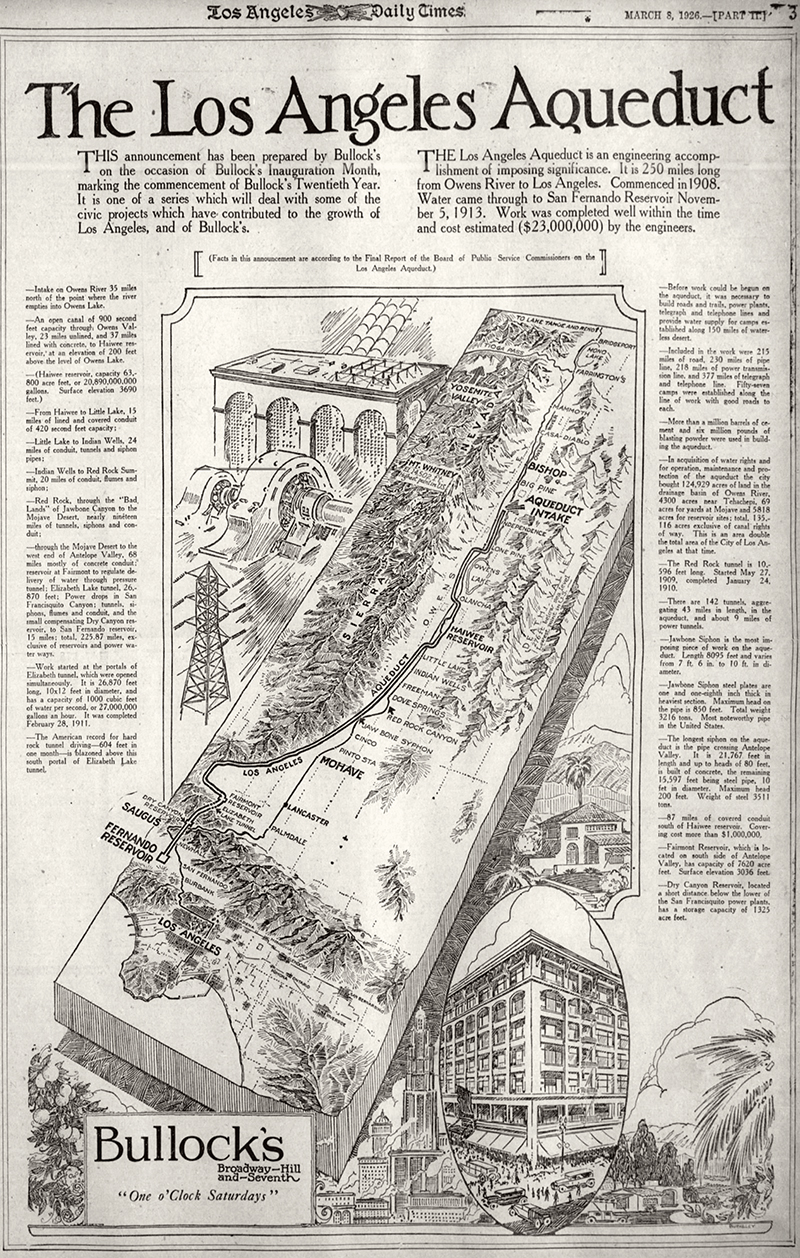
Click image to enlarge
This advertisement from the Bullock's department store was published in the Los Angeles Times on Monday, March 8, 1926, as construction of the St. Francis Dam was
nearing completion and the reservoir was just starting to be
filled at a rate of 70 million gallons per day. Artwork signed "Burkeley."
This announcement has been prepared by Bullock's on the occasion of Bullock's Inauguration Month, marking the commencement of Bullock's Twentieth Year. It is one of a series which will deal with some of the civic projects which have contributed to the growth of Los Angeles, and of Bullock's.
The Los Angeles Aqueduct is an engineering accomplishment of imposing significance. It is 250 miles long from Owens River to Los Angeles. Commenced in 1908, Water came through to San Fernando Reservoir November 5, 1913. Work was completed well within the time and cost estimated ($23,000,000) by the engineers.
(Facts in this announcement are according to the Final Report of the Board of Public Service Commissioners on the Los Angeles Aqueduct.)
- Intake on Owens River 35 miles north of the point where the river empties into Owens Lake.
- An open canal of 900 second feet capacity through Owens Valley, 23 miles unlined, and 37 miles lined with concrete, to Haiwee reservoir, at an elevation of 200 feet above the level of Owens Lake.
- (Haiwee reservoir, capacity 63,800 acre feet, or 20,890,000,000 gallons. Surface elevation 3690 feet.)
- From Haiwee to Little Lake, 15 miles of lined and covered conduit of 420 second feet capacity;
- Little Lake to Indian Wells, 24 miles of conduit, tunnels and siphon pipes;
- Indian Wells to Red Rock Summit, 20 miles of conduit, flumes and siphon;
- Red Rock, through the "Bad Lands" of Jawbone Canyon to the Mojave Desert, nearly nineteen miles of tunnels, siphons and conduit;
- through the Mojave Desert to the west end of Antelope Valley, 68 miles mostly of concrete conduit; reservoir at Fairmont to regulate delivery of water through pressure tunnel; Elizabeth Lake tunnel, 26,870 feet; Power drops in San Francisquito Canyon; tunnels, siphons, flumes and conduit, and the small compensating Dry Canyon reservoir, to San Fernando reservoir, 15 miles; total, 225.87 miles, exclusive of reservoirs and power water ways.
- Work started at the portals of Elizabeth tunnel, which were opened simultaneously. It is 26,870 feet long, 10x12 feet in diameter, and has a capacity of 1,000 cubic feet of water per second, or 27,000,000 gallons an hour. It was completed February 28, 1911.
- The American record for hard rock tunnel driving — 604 feet in one month — is blazoned above this south portal of Elizabeth Lake tunnel.
- Before work could be begun on the aqueduct, it was necessary to build roads and trails, power plants, telegraph and telephone lines and provide water supply for camps established along 150 miles of waterless desert.
- Included in the work were 215 miles of road, 230 miles of pipe line, 218 miles of power transmission line, and 377 miles of telegraph and telephone line. Fifty-seven ramps were established along the line of work with good roads to each.
- More than a million barrels of cement and six million rounds of blasting powder were used in building the aqueduct.
- In acquisition of water rights and for operation, maintenance and protection of the aqueduct the city bought 124,929 acres of land in the drainage basin of Owens River, 4,300 acres near Tehachepi, 69 acres for yards at Mojave and 5,818 acres for reservoir sites; total, 135,116 acres exclusive of canal rights of way. This is an area double the total area of the City of Los Angeles at that time.
- The Red Rock tunnel is 10,596 feet long. Started May 27, 1909, completed January 24, 1910.
- There are 142 tunnels, aggregating 43 miles in length, in the aqueduct, and about 9 miles of power tunnels.
- Jawbone Siphon is the most imposing piece of work on the aqueduct. Length 8,095 feet and varies from 7 ft. 6 in. to 10 ft. in diameter.
- Jawbone Siphon steel plates are one and one-eighth inch thick in heaviest section. Maximum head on the pipe is 850 feet. Total weight 3,216 tons. Most noteworthy pipe in the United States.
- The longest siphon on the aqueduct is the pipe crossing Antelope Valley. It is 21,767 feet in length and up to heads of 80 feet, is built of concrete, the remaining 15,597 feet being steel pipe, 10 feet in diameter. Maximum head 200 feet. Weight of steel 3,511 tons.
- 87 miles of covered conduit south of Haiwee reservoir. Covering cost more than $1,000,000.
- Fairmont Reservoir, which is located on south side of Antelope Valley, has capacity of 7,620 acre feet. Surface elevation 3036 feet.
- Dry Canyon Reservoir, located a short distance below the lower of the San Francisquito power plants, has a storage capacity of 1,325 acre feet.
9600 dpi jpeg from scanned newspaper.
|
More Photos:
* Opening 11-5-1913
* 100th Anniversary

Archive Footage

Complete Report on Construction 1916

Book: The Water Seekers (Nadeau 1950)

Route Map 1908

Workers Angered by Pay Cut, Spoiled Food 1909

Saugus Division Tunnel 1909

Photo Album: Construction 1908-1913

Construction 1910

Power House 1, ~1910

Elizabeth Tunnel 1910

Whitney Siphon 1910

Saugus HQ 1907-12 x3

Water Canyon Postcard 1911

Letter of Recommendation 1912

Jawbone Siphon ~1912

Cement Plant, Newhall ~1912

Jawbone Siphon 1913

Canyon Country ~1913

Newhall ~1913

Deadman Canyon Siphon, Saugus x2

Cascades 1914

Cascades 1915

Power House 1
Construction 1915

Terminus 1918

Placerita x3

Annual Report 1923
McGroarty History 1923

Map & Facts, Bullock's 1926

Annual Report 1929

LADWP Propaganda
1926 (Rev. 1932)

Bouquet Dam 1933-34

Saugus Nuclear Plant 1960

Jawbone Siphon 1960s

Jawbone Siphon 2016 (26)

LADWP House at Dry Canyon Reservoir 2020
|


































